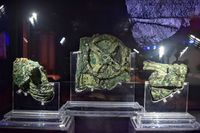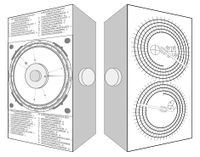Antikythera Mechanism
The Antikythera Mechanism is a mechanical device of ancient Greek origin that has been cited by pseudoarchaeologists as evidence of their beliefs about ancient aliens.

Background
Discovery
In the year 1900, a team of sponge divers discovered an ancient shipwreck off the coast of Antikythera, a small Greek island in the Aegean Sea. Subsequently, the wreck was partially salvaged by the sponge divers under the supervision of Antonios Oikonomos, professor of archaeology at the University of Athens. However, factors including adverse weather conditions and the divers’ lack of training prevented the operation from being conducted in an “archaeologically scientific” manner. The ship is now believed to have been a merchant vessel that sank around 60 BC on its way to the western Mediterranean. The artifacts recovered from the wreck included bronze statues, some from the 3rd and 4th centuries BC; the most notable is the “Ephebe of Antikythera.” There were also marble statues, amphorae, ceramics, glassware, and coins. Though it is by far the most famous of the artifacts today, at the time little attention was paid to what would come to be known as the Antikythera Mechanism.[2]
Research
The first major investigation of the Antikythera Mechanism did not occur until eight months after the artifact arrived at the Archaeological Museum. attempting to decipher the visible Ancient Greek inscriptions on the Mechanism. x-ray in order to view the inner workings of the Mechanism. This greatly increased knowledge about the Mechanism, but it was limited because the x-rays did not show the depth of the gears in relation to each other within the device. Based on this, de Solla Price attempted to reconstruct the Mechanism's gear train, although with the available information his reconstruction was only speculative. linear tomography Research has been continued in the 21st century by the Antikythera Mechanism Research Project (AMRP). The use of reflectance transformation imaging (RTI) and X-ray computed tomography have allowed for "improved readings of the inscribed texts and enhanced knowledge of mechanical and physical details."[3] Using this information, the researchers arrived at a new reconstruction of the gear train that was published in 2006.
The Mechanism

The Antikythera Mechanism is in a fragmentary state- approximately 82 fragments in all, though some may or may not be part of the Mechanism. Originally it was in a wooden frame (now mostly disintegrated) and is estimated to have been about 315 x 190 x 100 mm (approx. 12 x 7.5 x 4 inches).[5]
On what is referred to as the back side of the Mechanism were two large dials around which pointers could be moved. The labels of the dials were spirals divided into small sections, with each section containing an inscription. The top spiral dial was the Metonic dial; inside of the spiral there were also two smaller dials, the Callippic dial and the Games dial. The bottom spiral dial was the Saros dial, which enclosed the smaller Exeligmos dial.
The inscriptions of the back dials were as follows:
- The Metonic dial: labeled with lunar months in a 19-year cycle
- The Callippic dial: labeled with 19-year cycles within a 76-year cycle
- The Games Dial: labeled with the cycle of the Olympic Games and other sporting events
- The Saros dial: labeled with the dates of potential lunar or solar eclipses
- The Exeligmos dial: labeled with extra hours to be added to a cycle of 223 lunar months
The front had only one dial, which was labeled with the 12 zodiac signs as well as the months of the Egyptian calendar. It also had small markings dividing the circumference into 365 equal sections. This dial had multiple pointers to represent the Sun, moon, and planets. There were additional inscriptions surrounding the front and back dials that explained the Mechanism's functions.
The inner workings of the machine included at least 30 known gears, cut from bronze, with triangular teeth cut at a 60 degree angle. There have been multiple different reconstructions of the gear train proposed over time.
Origin
The place where the Mechanism was originally manufactured is not known, but it has been suggested that it was made in Rhodes. First of all, the Games dial has an inscription reading “Halieia,” a minor local festival that occurs in Rhodes.
Function
After the discovery, it was initially suggested that the Antikythera Mechanism was some sort of navigational tool. This seemed logical since it was discovered on a ship, but otherwise there is not much evidence to support the idea. Over the decades, many people theorized that the Mechanism had the ability to model the movement of the planets in addition to the sun and moon. This could not be proven, however, due to the incompleteness of the Mechanism's surviving fragments. It was only after the AMRP's research allowed more of the plate inscriptions to be read that it became clear that there were originally pointers to represent the five planets. It is still a matter of speculation as to why the Mechanism was built; in A Portable Cosmos, Alexander Jones suggests that it was intended primarily as an educational tool rather than having a practical purpose.
Pseudoarchaeological Claims
Ancient alien theorists have cited the Antikythera Mechanism as an example of an artifact they believe is too advanced for ancient humans to have built without help from extraterrestrials. In Chariots of the Gods, Erich von Daniken includes the Mechanism in a long list of artifacts that he believes archaeologists cannot explain.[6] The Mechanism is also featured in season 3, episode 8 of Ancient Aliens, “Mysterious Devices,” which also posits that the Great Pyramid of Giza was actually an ancient power plant. Author and self-described “rogue archaeologist” David Childress (who has no real archaeological credentials)[7] says that the Antikythera Mechanism is so unbelievably advanced that its discovery was like “finding a jet engine in the tomb of King Tut.” Alien hunter Jason Martell claims that “it had more complicated inner workings than a modern-day Swiss watch” and that no one knows “who could have created it and what it was used for.”[8]
Venturing into the wilderness of the internet, we can find a great deal more interesting content on the subject. TheAncientAliens.com has an article about the Antikythera Mechanism asserting that "if a contemporary metal shop were commissioned to build this device today, the craftsmen would have to use a computer to draw the forms, and a precision CNC cutter to machine the parts from bronze."[9] On the website of Tana Hoy, "the world's foremost psychic," an article asks, if the ancient Greeks had the knowledge displayed in the Mechanism, "why weren't they able to conceive of simpler technology such as a bread toaster?"[10]
Analysis
It is true that even legitimate scholars have described the Antikythera Mechanism as being remarkable. In fact, David Childress was merely echoing the words of Derek de Solla Price, the first scholar to write a book about the Mechanism, who said that its discovery was “like opening a pyramid and finding an atomic bomb.”[11] However, there is no reason to believe that aliens were involved in the construction of the Mechanism.
The fact that the Antikythera Mechanism is not quite like anything else in the archaeological record does not mean that it must have arrived suddenly from an outside (in this case, extraterrestrial) source. The Mechanism is sophisticated enough to imply that other prototype devices must have come before it, meaning that is likely that there are other examples of this kind of technology that have not survived from antiquity. Since metal was valuable, it was often recycled. Even the Mechanism itself barely survived, and only came down to us in a corroded, fragmentary, incomplete form.
Pseudoarchaeologists also tend to exaggerate how advanced the Mechanism really is. In fact, in spite of its complexity, it still reflects the technological limitations of the civilization from which it arose. For instance, the Mechanism’s gears all have triangular teeth, which are less efficient than modern gear teeth and consistent with other early mechanical devices. It also shows the shortcomings of the Greeks' astronomical knowledge, such as the fact that they had only discovered five of our solar system's planets, as well as their inability to predict eclipses with complete accuracy and precision.
As de Solla Price wrote, "the whole story of Greek science makes a great deal more sense if we assume that the old view of their rising no higher than the simple Heronic devices was a drastic underestimation that can now be corrected."[12] This is how science works; our view of the world changed when we discovered new evidence that contradicted what we thought we knew before. Applying Occam's Razor, it is much simpler to assume that we had incomplete knowledge of the technological capabilities of the Ancient Greeks, than it is to assume that aliens visited Earth, imparted to the Greeks the knowledge they needed to build an analog computing device, and then vanished without leaving any other trace.
References
- ↑ https://www.flickr.com/photos/135146612@N03/30672909980
- ↑ [1]A Portable Cosmos: Revealing the Antikythera Mechanism, Scientific Wonder of the Ancient World by Alexander Jones (Oxford University Press, 2017)
- ↑ [2]A Portable Cosmos: Revealing the Antikythera Mechanism, Scientific Wonder of the Ancient World by Alexander Jones (Oxford University Press, 2017)
- ↑ https://www.sciencefocus.com/space/the-antikythera-mechanism-the-ancient-greek-computer-that-mapped-the-stars/
- ↑ [3] "Decoding the ancient Greek astronomical calculator known as the Antikythera Mechanism" by T. Freeth et al. (Nature, 30 November 2006)
- ↑ [4] Chariots of the Gods by Erich von Daniken
- ↑ [5] David Childress RationalWiki article
- ↑ [6] Ancient Aliens Season 8, Episode 3: Mysterious Devices
- ↑ [7] Alien Technology: The Antikythera Mechanism
- ↑ [8] "Historical Proof of Aliens: Are They For Real? – Part 2" by Tana Hoy
- ↑ [9] “'Like Opening a Pyramid and Finding an Atomic Bomb': Derek de Solla Price and the Antikythera Mechanism" by Alexander Jones (Proceedings of the American Philosophical Society, September 2018
- ↑ [10] "Gears from the Greeks" by Derek de Solla Price (Transactions of the American Philosphical Society, 1974)